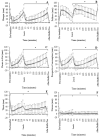Lower Energy-Dense Ready Meal Consumption Affects Self-Reported Appetite Ratings with No Effect on Subsequent Food Intake in Women
- PMID: 34960060
- PMCID: PMC8708992
- DOI: 10.3390/nu13124505
Lower Energy-Dense Ready Meal Consumption Affects Self-Reported Appetite Ratings with No Effect on Subsequent Food Intake in Women
Abstract
Slimming World (SW), a commercial weight management organisation, has designed a range of low energy-dense ready meals (LEDRMs) in line with their programme. This randomised crossover study compared commercially available equicaloric ready meals differing in energy density on satiety and food intake. It was hypothesised that the LEDRM would reduce energy intake (EI) whilst increasing fullness and reducing hunger compared to higher energy-dense ready meal (HEDRM, control). A total of 26 female participants (aged 18-65 years; body mass index of 28.8 ± 3.0 kg·m-2) attended two test days. The participants ate a standard breakfast, and four hours later, ate either a LEDRM or HEDRM at lunch. EI was measured four hours later at an ad libitum tea. Satiety measurements were recorded throughout the day using visual analogue scales and a weighed food diary was completed for the remainder of the day. The results revealed that the LEDRM reduced hunger and increased fullness (both p < 0.001). There was no difference in EI at the evening meal between the ready meals (p > 0.05), however, during the whole LEDRM testing day, the participants consumed significantly less fat (7.1%) and saturated fat (3.6%) (both p < 0.01), but significantly more carbohydrates, sugars, fibre, protein, and salt (all p < 0.01). The results indicate that the participants felt more satiated after consuming ready meals of the same energy content but larger portion size. Despite no significant difference in short-term EI between the ready meals, the results indicated that the LEDRM produced beneficial subjective satiety responses and, therefore, can help to improve the nutritional content of meals i.e., reduce saturated fat consumption.
Keywords: appetite; energy density; food intake; ready meals; satiety.
Conflict of interest statement
The authors declare no potential conflict of interest with respect to the research, authorship, and/or publication of this article. The funders had no role in the final design of the study; in the collection, analyses, or interpretation of data; in the writing of the manuscript, or in the decision to publish the results.
Figures





Similar articles
-
Variation in the Oral Processing of Everyday Meals Is Associated with Fullness and Meal Size; A Potential Nudge to Reduce Energy Intake?Nutrients. 2016 May 21;8(5):315. doi: 10.3390/nu8050315. Nutrients. 2016. PMID: 27213451 Free PMC article.
-
Variation in the effects of three different breakfast meals on subjective satiety and subsequent intake of energy at lunch and evening meal.Eur J Nutr. 2013 Jun;52(4):1353-9. doi: 10.1007/s00394-012-0444-z. Epub 2012 Sep 5. Eur J Nutr. 2013. PMID: 22948783 Clinical Trial.
-
Postprandial appetite ratings are reproducible and moderately related to total day energy intakes, but not ad libitum lunch energy intakes, in healthy young women.Appetite. 2016 Apr 1;99:97-104. doi: 10.1016/j.appet.2015.12.031. Epub 2016 Jan 5. Appetite. 2016. PMID: 26763471
-
The influence of food portion size and energy density on energy intake: implications for weight management.Am J Clin Nutr. 2005 Jul;82(1 Suppl):236S-241S. doi: 10.1093/ajcn/82.1.236S. Am J Clin Nutr. 2005. PMID: 16002828 Review.
-
Effects of Whole Grain Intake, Compared with Refined Grain, on Appetite and Energy Intake: A Systematic Review and Meta-Analysis.Adv Nutr. 2021 Jul 30;12(4):1177-1195. doi: 10.1093/advances/nmaa178. Adv Nutr. 2021. PMID: 33530093 Free PMC article.
Cited by
-
Relation Between Obesity and Type 2 Diabetes: Evolutionary Insights, Perspectives and Controversies.Curr Obes Rep. 2024 Sep;13(3):475-495. doi: 10.1007/s13679-024-00572-1. Epub 2024 Jun 8. Curr Obes Rep. 2024. PMID: 38850502 Review.
-
The Effectiveness of Nutritional Strategies in the Treatment and Management of Obesity: A Systematic Review.Cureus. 2023 Sep 19;15(9):e45518. doi: 10.7759/cureus.45518. eCollection 2023 Sep. Cureus. 2023. PMID: 37868473 Free PMC article. Review.
-
Exploring the Potential Benefits of Natural Calcium-Rich Mineral Waters for Health and Wellness: A Systematic Review.Nutrients. 2023 Jul 13;15(14):3126. doi: 10.3390/nu15143126. Nutrients. 2023. PMID: 37513544 Free PMC article.
-
Update on Obesity and Cardiovascular Risk: From Pathophysiology to Clinical Management.Nutrients. 2024 Aug 20;16(16):2781. doi: 10.3390/nu16162781. Nutrients. 2024. PMID: 39203917 Free PMC article. Review.
-
The Role of Nutrition in Obesity.Nutrients. 2023 May 30;15(11):2556. doi: 10.3390/nu15112556. Nutrients. 2023. PMID: 37299519 Free PMC article.
References
-
- World Health Organisation Overweight and Obesity. 2020. [(accessed on 8 February 2019)]. Available online: http://www.who.int/mediacentre/factsheets/fs311/en/
-
- NHS Digital Obesity Statistics. 2021. [(accessed on 19 October 2021)]. Available online: https://researchbriefings.files.parliament.uk/documents/SN03336/SN03336.pdf.
-
- National Institute for Health and Care Excellence Weight Management: Lifestyle Services for Overweight or Obese Adults. 2014. [(accessed on 6 February 2019)]. Available online: https://www.nice.org.uk/guidance/ph53/chapter/1 Recommendations.
Publication types
MeSH terms
Grants and funding
LinkOut - more resources
Full Text Sources
Research Materials

